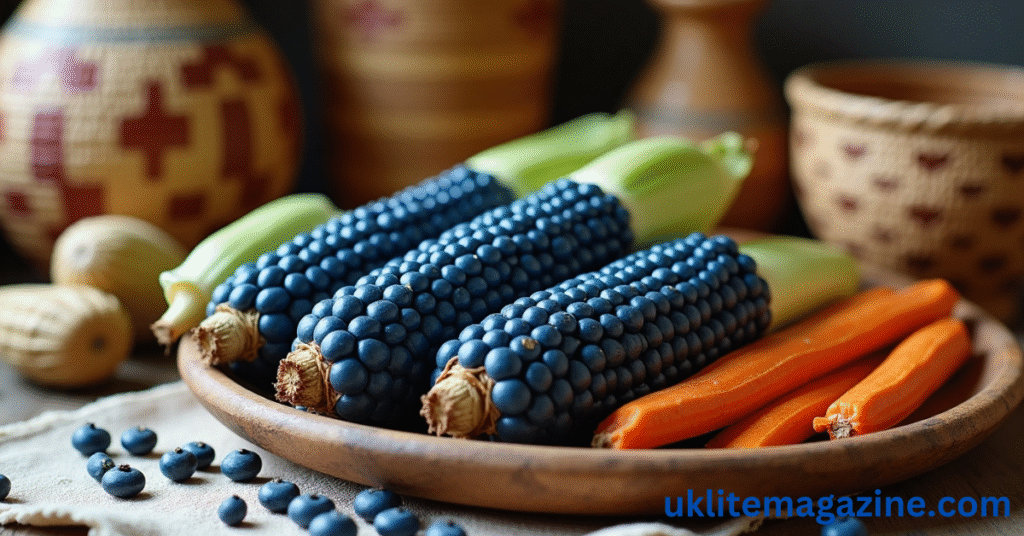Blue corn isn’t just beautiful—it’s packed with history, nutrition, and flavor. You may have seen it in blue tortillas or corn chips, but there’s much more to this colorful grain than meets the eye. In this complete guide, we’ll explore what blue corn is, where it comes from, why it’s considered a healthy alternative, and how you can use it in your kitchen.
What Is Blue Corn?
Blue corn is a variety of flint maize, known for its deep blue to purple kernels. Its unique color comes from anthocyanins, a group of powerful antioxidants also found in blueberries and purple cabbage.
Unlike sweet corn, which is eaten fresh, blue corn is usually dried and ground into meal or flour. It’s used in many traditional and modern recipes, including tortillas, chips, pancakes, and even drinks.
Origins and History
Blue corn has a long and rich history, dating back thousands of years to Native American cultures, particularly the Hopi, Pueblo, and Navajo tribes in the American Southwest.
For these communities, blue corn isn’t just food—it’s a sacred crop with spiritual and cultural importance. It’s often used in ceremonies and is considered a symbol of health, strength, and resilience.
Nutritional Value of Blue Corn
One reason blue corn is growing in popularity is its nutritional profile. Here’s how it compares to regular yellow or white corn:
| Nutrient | Blue Corn (per 100g) | Yellow Corn (per 100g) |
|---|---|---|
| Calories | ~360 kcal | ~365 kcal |
| Protein | 9–10g | 8–9g |
| Fiber | 7–8g | 5–6g |
| Antioxidants | High (Anthocyanins) | Low |
| Gluten-Free | Yes | Yes |
Blue corn is particularly rich in fiber, protein, and antioxidants, which makes it a heart-healthy and anti-inflammatory option for many diets.
Health Benefits of Blue Corn
Here are some potential health benefits of including blue corn in your meals:
-
Rich in antioxidants: Anthocyanins may help reduce the risk of heart disease and improve brain function.
-
Better blood sugar control: Some studies suggest that blue corn has a lower glycemic index than yellow corn, which may benefit people with diabetes.
-
High fiber content: Supports digestive health and helps in weight management.
-
Naturally gluten-free: Safe for people with celiac disease or gluten intolerance.
How Blue Corn Is Grown
Blue corn grows similarly to other types of corn but is mostly cultivated in dry, arid regions like the Southwestern United States and Mexico.
It’s a harder and denser grain compared to sweet corn, which means it requires more processing (grinding) to be used in food. Farmers often harvest it after the kernels have completely dried on the stalk.
Culinary Uses of Blue Corn
Blue corn is extremely versatile in the kitchen. Here are some common ways to use it:
-
Blue corn tortillas – Rich, nutty flavor, perfect for tacos and wraps.
-
Blue corn chips – Crunchy and colorful, often served with salsa or guacamole.
-
Blue cornmeal pancakes – A healthy twist on traditional breakfast.
-
Atoles and drinks – Traditional Mexican beverages made with blue cornmeal.
It has a slightly sweeter and nuttier flavor than yellow corn, making it a unique ingredient for both savory and sweet dishes.
Where to Buy Blue Corn Products
Blue corn and its products are becoming more widely available. You can find them at:
-
Health food stores
-
Organic markets
-
Online retailers like Amazon or Thrive Market
-
Mexican and Native American food suppliers
Look for organic, non-GMO blue cornmeal or flour if you want the cleanest product possible.
Conclusion
Blue corn is more than just a colorful alternative to traditional corn—it’s a nutrient-rich, culturally significant, and delicious grain that deserves a place in your kitchen. Whether you’re trying to eat healthier, explore indigenous ingredients, or simply enjoy its rich flavor, blue corn is worth trying.
Frequently Asked Questions (FAQs)
1. Is blue corn genetically modified?
No, most blue corn is non-GMO, especially when purchased from organic or specialty stores.
2. Can I substitute blue corn for yellow corn in recipes?
Yes, especially in recipes like cornbread, tortillas, and chips. However, the flavor and texture may be slightly different.
3. Does blue corn taste different?
Yes. Blue corn has a richer, nuttier flavor compared to yellow or white corn.
4. Is blue corn gluten-free?
Yes. Like all corn, blue corn is naturally gluten-free.

